
| Version | Summary | Created by | Modification | Content Size | Created at | Operation |
|---|---|---|---|---|---|---|
| 1 | Beatrix Zheng | -- | 1540 | 2022-11-07 01:47:48 |
Video Upload Options
The soils of the Kilte Awula’ilo woreda (district) in Tigray reflect its longstanding agricultural history, highly seasonal rainfall regime, relatively low temperatures, the presence of a wide depression at the foot of the Atsbi horst and steep slopes. Outstanding features in the soilscape are the wide ancient fluvial deposits, the soils of the granite batholith, cuestas and fertile lands behind tufa dams.
1. Factors Contributing to Soil Diversity
1.1. Climate
Annual rainfall depth is very variable with an average of around 600 mm.[1] Most rains fall during the main rainy season, which typically extends from June to September. Mean temperature in woreda town Wuqro is 22.2 °C, oscillating between average daily minimum of 12.6 °C and maximum of 31.1 °C. The contrasts between day and night air temperatures are much larger than seasonal contrasts.[2]
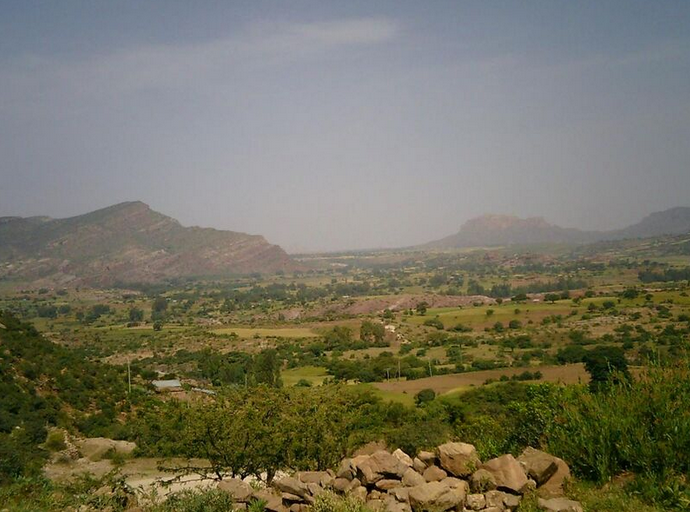
1.2. Geology
The following geological formations are present:[3]
- Agula Shale[4]
- Antalo Limestone
- Adigrat Sandstone
- Enticho Sandstone
- Edaga Arbi Glacials
- Precambrian metamorphic rocks
- Quaternary alluvium and freshwater tufa[5]
1.3. Topography
As part of the Ethiopian highlands the land has undergone a rapid tectonic uplift, leading the occurrence of mountain peaks, plateaus, valleys and gorges.
1.4. Land Use
Generally speaking, the level lands and intermediate slopes are occupied by cropland, while there is rangeland and shrubs on the steeper slopes. Remnant forests occur around Orthodox Christian churches and a few inaccessible places. A recent trend is the widespread planting of eucalyptus trees.
1.5. Environmental Changes
Soil degradation in this district became important when humans started deforestation almost 5000 years ago.[6][7] Depending on land use history, locations have been exposed in varying degrees to such land degradation.
2. Geomorphic Regions and Soil Units
Given the complex geology and topography of the district, it has been organised into land systems - areas with specific and unique geomorphic and geological characteristics, characterised by a particular soil distribution along the soil catena.[8][9][10] Soil types are classified in line with World Reference Base for Soil Resources and reference made to main characteristics that can be observed in the field.
2.1. Wuqro Fluvial Landscape
- Associated soil types
- shallow, stony, dark, loamy soils on calcaric material (Rendzic Leptosol) (3)
- moderately deep dark stony clays with good natural fertility (Vertic Cambisol) (10)
- deep dark cracking clays with very good natural fertility, waterlogged during the wet season (Chromic Vertisol, Pellic Vertisol) (12)
- Inclusions
- shallow, stony loam soils with moderate fertility (Eutric Regosol and Cambisol) (21)
- Brown, silty loams to loamy sands developed on alluvium, with good natural fertility ((Mollic) Fluvisol, Fluvic Cambisol (29)
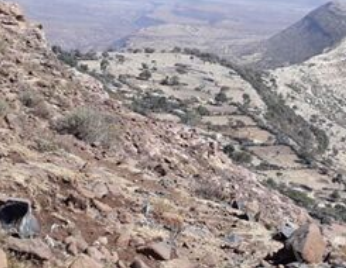
2.2. Incised Giba Plateau, Upstream of (Future) Lake Giba
- Associated soil types
- complex of rock outcrops, very stony and very shallow soils ((Lithic) Leptosol) (1)
- shallow, stony, dark, loamy soils on calcaric material (Rendzic Leptosol) (3)
- shallow to very shallow, very stony, loamy soils (Skeletic/Leptic Cambisol and Regosol) (4)
- Inclusions
- Shallow, stony loam soils with moderate fertility (Eutric Regosol and Cambisol) (21)
- Deep, dark cracking clays with good fertility, but problems of waterlogging (Chromic and Pellic Vertisol) (12)
- Brown to dark, silty clay loams to loamy sands developed on alluvium, with good natural fertility (Fluvisol) (30)
2.3. Deeply Incised Mountainous Area (Escarpment towards Atsbi)
File:CeI2 Steep incised mountainous area catena.tif
- Associated soil types
- complex of rock outcrops, very stony and very shallow soils ((Lithic) Leptosol) (1)
- shallow, very stony, silt loamy to loamy soils (Skeletic Cambisol, Leptic Cambisol, Skeletic Regosol) (4)
- Inclusions
- stony dark cracking clays with good natural fertility (Vertic Cambisol) (10)
- shallow, stony loam soils with moderate fertility (Eutric Regosol and Cambisol) (21)
2.4. Ancient River Terraces

- Associated soil types
- shallow, stony, dark, loamy soils on calcaric material (Rendzic Leptosol) (3)
- Deep, dark cracking clays with good fertility, but problems of waterlogging (Chromic and Pellic Vertisol) (12)
- moderately deep, red-brownish, loamy soils with a good natural fertility (Chromic Luvisol) (20)
- Brown to dark, silty clay loams to loamy sands developed on alluvium, with good natural fertility (Fluvisol) (30)
- Inclusions
- complex of rock outcrops, very stony and very shallow soils ((Lithic) Leptosol) (1)
- shallow to very shallow, very stony, loamy soils (Skeletic/Leptic Cambisol and Regosol) (4)
- shallow, dark, stony, loamy soils on calcaric material, rich on organic matter (Calcaric Mollic Cambisol) (23)
2.5. Alluvial Plains Induced by Tufa Dams
- Dominant soil type: deep dark cracking clays with very good natural fertility, waterlogged during the wet season (Chromic Vertisol, Pellic Vertisol) (12)
- Associated soil type: stony, dark cracking clays with good natural fertility (Vertic Cambisol) (10)
- Inclusions
- shallow, stony, dark, loamy soils on calcaric material (Rendzic Leptosol) (3)
- shallow, very stony, silt loamy to loamy soils (Skeletic Cambisol, Leptic Cambisol, Skeletic Regosol) (4)
2.6. Incised Agula Shale Plateau
- Associated soil types
- complex of rock outcrops, very stony and very shallow soils ((Lithic) Leptosol) (1)
- shallow, very stony, silt loamy to loamy soils (Skeletic Cambisol, Leptic Cambisol, Skeletic Regosol) (4)
- moderately deep, red-brownish, loamy soils with a good natural fertility (Chromic Luvisol) (20)
- Inclusions
- moderately deep dark stony clays with good natural fertility (Vertic Cambisol) (10)
- deep, dark cracking clays on calcaric material (Calcaric Vertisol, Calcic Vertisol) (11)
- deep dark cracking clays with very good natural fertility, waterlogged during the wet season (Chromic Vertisol, Pellic Vertisol) (12)
- shallow, stony loam soils (Eutric Regosol and Cambisol) (21)
2.7. Gently Rolling Antalo Limestone plateau, Holding Cliffs and Valley Bottoms
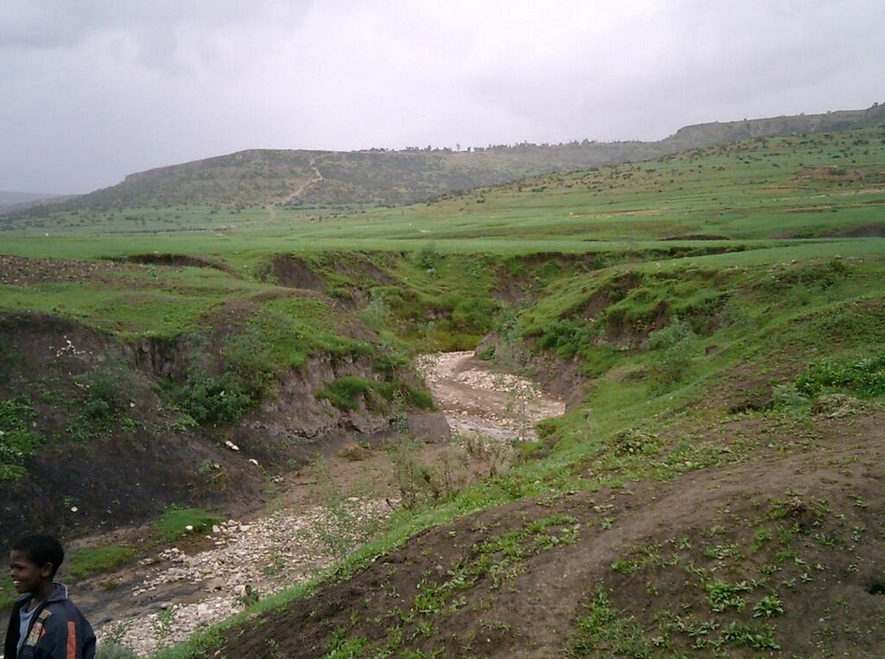
- Associated soil types
- shallow stony soils with a dark surface horizon overlying calcaric material (Calcaric Leptosol) (3)
- moderately deep dark stony clays with good natural fertility (Vertic Cambisol) (10)
- deep, dark cracking clays on calcaric material (Calcaric Vertisol, Calcic Vertisol) (11)
- Inclusions
- Rock outcrops and very shallow soils (Lithic Leptosol) (1)
- Shallow very stony loamy soil on limestone (Skeletic Calcaric Cambisol) (5)
- Deep dark cracking clays with very good natural fertility, waterlogged during the wet season (Chromic Vertisol, Pellic Vertisol) (12)
- Brown to dark sands and silt loams on alluvium (Vertic Fluvisol, Eutric Fluvisol, Haplic Fluvisol) (30)
2.8. Cuesta Landscape
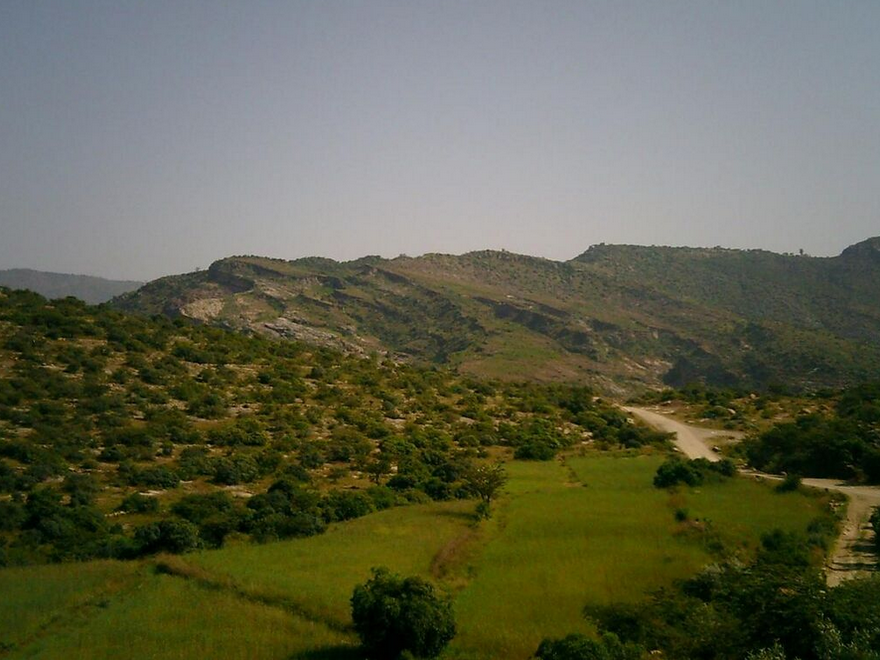
- Dominant soil type: complex of rock outcrops, very stony and very shallow soils ((Lithic) Leptosol) (1)
- Associated soil type: shallow, very stony, silt loamy to loamy soils (Skeletic Cambisol, Leptic Cambisol, Skeletic Regosol) (4)
- Inclusions
- shallow, stony, dry soils on colluvium (Colluvic Leptosol) (8)
- shallow to moderately deep, stony, brown loamy soils on calcaric material (Calcic Cambisol and Luvisol) (25)
2.9. Atsaf and Menda’i Plains

Lithic Leptosols around Abreha and Atsbeha church at the edge of Menda'i plain. https://handwiki.org/wiki/index.php?curid=1480266
- Associated soil types
- moderately deep, red-brownish, loamy soils with a good natural fertility (Chromic Luvisol) (20)
- shallow, stony loam soils with moderate fertility (Eutric Regosol and Cambisol) (21)
- sandy clay loams to sands developed on sandy colluvium (Eutric Arenosol, Regosol, Cambisol) (24)
- clays of floodplains with very high watertable with moderate to good natural fertility (Eutric Gleysol, Gleyic Cambisol) (33)
- Inclusions
- complex of rock outcrops, very stony and very shallow soils ((Lithic) Leptosol) (1)
- shallow, very stony, silt loamy to loamy soils (Skeletic Cambisol, Leptic Cambisol, Skeletic Regosol) (4)
2.10. Suluh Plains with Metavolcanic Rocks
- Associated soil types
- complex of rock outcrops, very stony and very shallow soils ((Lithic) Leptosol) (1)
- moderately deep, red-brownish, loamy soils with a good natural fertility (Chromic Luvisol) (20)
- shallow, stony loam soils (Eutric Regosol and Cambisol) (21)
- Inclusions
- shallow, very stony, silt loamy to loamy soils (Skeletic Cambisol, Leptic Cambisol, Skeletic Regosol) (4)
- clays of floodplains with very high watertable with moderate to good natural fertility (Eutric Gleysol, Gleyic Cambisol) (33)
2.11. Negash Geosyncline
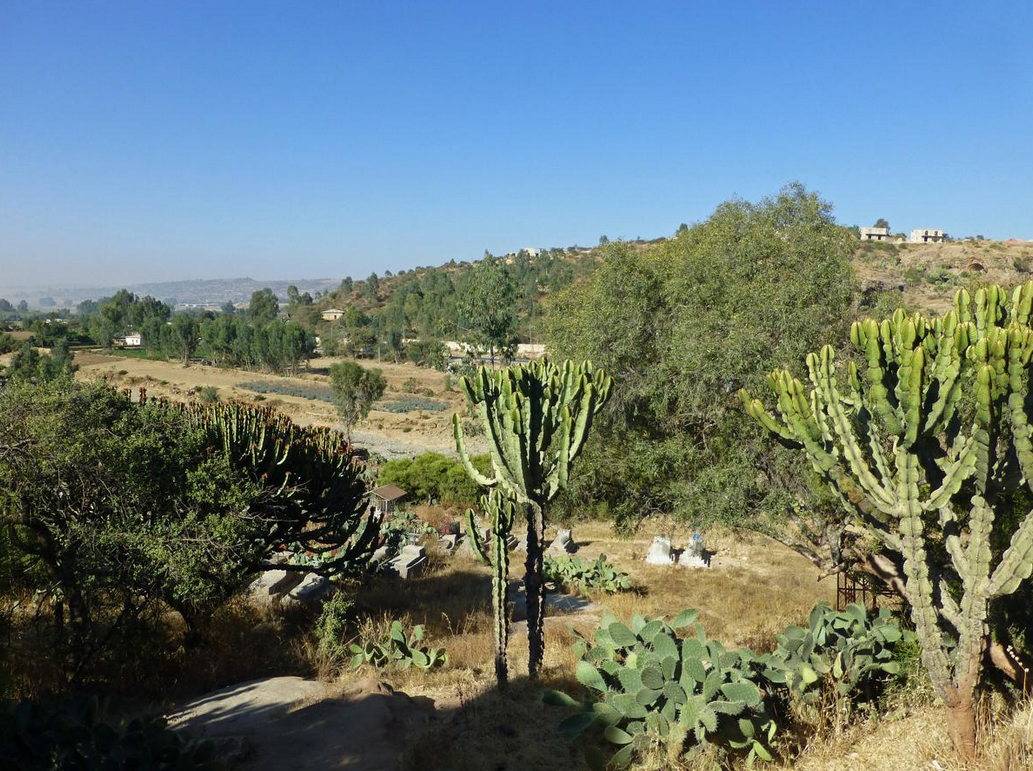
- Dominant soil type: shallow, stony loam soils (Eutric Regosol and Cambisol) (21)
- Associated soil types
- complex of rock outcrops, very stony and very shallow soils ((Lithic) Leptosol) (1)
- Inclusions
- moderately deep, brown loamy soils ((Eutric) Luvisol) (26)
- clays of floodplains with very high watertable with moderate to good natural fertility (Eutric Gleysol, Gleyic Cambisol) (33)
2.12. Circular Granite Batholith (Intrusive)
- Dominant soil type: shallow, stony loam soils with moderate fertility (Eutric Regosol and Cambisol) (21)
- Associated soil type: complex of rock outcrops, very stony and very shallow soils ((Lithic) Leptosol) (1)
- Inclusions
- shallow, very stony, silt loamy to loamy soils (Skeletic Cambisol, Leptic Cambisol, Skeletic Regosol) (4)
- clays of floodplains with very high watertable with moderate to good natural fertility (Eutric Gleysol, Gleyic Cambisol) (33)
3. Soil Erosion and Conservation
The reduced soil protection by vegetation cover, combined with steep slopes and erosive rainfall has led to excessive soil erosion.[6][11][12] Nutrients and organic matter were lost and soil depth was reduced. Hence, soil erosion is an important problem, which results in low crop yields and biomass production.[13] Given the strong degradation and thanks to the hard labour of many people in the villages, soil conservation is carried out on a large scale since the 1980s and especially 1980s; this has curbed rates of soil loss.[14] Measures include the construction of infiltration trenches, stone bunds,[15] check dams,[16] small reservoirs such as La'ilay Wuqro and May Azaboy as well as a major biological measure: exclosures in order to allow forest regeneration.[17] On the other hand, it remains difficult to convince farmers to carry out measures within the farmland (in situ soil management), such as bed and furrows or zero grazing, as there is a fear for loss of income from the land. Such techniques are however very effective.[18]
References
- Jacob, M. and colleagues (2013). "Assessing spatio-temporal rainfall variability in a tropical mountain area (Ethiopia) using NOAAs Rainfall Estimates.". International Journal of Remote Sensing 34 (23): 8305–8321. doi:10.1080/01431161.2013.837230. Bibcode: 2013IJRS...34.8319J. https://biblio.ugent.be/publication/4252226.
- Jacob, M. and colleagues (2019). Dogu'a Tembien's Tropical Mountain Climate. In: Geo-trekking in Ethiopia's Tropical Mountains — The Dogu'a Tembien District. SpringerNature. doi:10.1007/978-3-030-04955-3_3. ISBN 978-3-030-04954-6. https://dx.doi.org/10.1007%2F978-3-030-04955-3_3
- Sembroni, A.; Molin, P.; Dramis, F. (2019). Regional geology of the Dogu'a Tembien massif. In: Geo-trekking in Ethiopia's Tropical Mountains — The Dogu'a Tembien District. SpringerNature. ISBN 978-3-030-04954-6. https://www.springer.com/gp/book/9783030049546.
- Bosellini, A.; Russo, A.; Fantozzi, P.; Assefa, G.; Tadesse, S. (1997). "The Mesozoic succession of the Mekelle Outlier (Tigrai Province, Ethiopia).". Mem. Sci. Geol. 49: 95–116.
- Moeyersons, J. and colleagues (2006). "Age and backfill/overfill stratigraphy of two tufa dams, Tigray Highlands, Ethiopia: Evidence for Late Pleistocene and Holocene wet conditions.". Palaeogeography, Palaeoclimatology, Palaeoecology 230 (1–2): 162–178. doi:10.1016/j.palaeo.2005.07.013. Bibcode: 2006PPP...230..165M. https://dx.doi.org/10.1016%2Fj.palaeo.2005.07.013
- "Human impact on the environment in the Ethiopian and Eritrean highlands - a state of the art.". Earth-Science Reviews 64 (3–4): 273–320. 2004. doi:10.1016/S0012-8252(03)00078-3. https://dx.doi.org/10.1016%2FS0012-8252%2803%2900078-3
- Blond, N. and colleagues (2018). "Terrasses alluviales et terrasses agricoles. Première approche des comblements sédimentaires et de leurs aménagements agricoles depuis 5000 av. n. è. à Wakarida (Éthiopie).". Géomorphologie: Relief, Processus, Environnement 24 (3): 277–300. doi:10.4000/geomorphologie.12258. https://dx.doi.org/10.4000%2Fgeomorphologie.12258
- Bui, E.N. (2004). "Soil survey as a knowledge system.". Geoderma. 120 (1–2): 17–26. doi:10.1016/j.geoderma.2003.07.006. Bibcode: 2004Geode.120...17B. https://dx.doi.org/10.1016%2Fj.geoderma.2003.07.006
- "Principes de la cartographie des pédopaysages dans les Alpes". Écologie 29 (1–2): 49. 1998. ProQuest 223074690. https://search.proquest.com/docview/223074690
- Tielens, Sander (2012). Towards a soil map of the Geba catchment using benchmark soils. MSc thesis.. Leuven, Belgium: K.U.Leuven.
- Demel Teketay (2001). "Deforestation, wood famine, and environmental degradation in Ethiopia's highland ecosystems: urgent need for action.". Northeast African Studies 8 (1): 53–76. doi:10.1353/nas.2005.0020. https://dx.doi.org/10.1353%2Fnas.2005.0020
- Nyssen, Jan; Frankl, Amaury; Zenebe, Amanuel; Deckers, Jozef; Poesen, Jean (2015). "Land management in the northern Ethiopian highlands: local and global perspectives; past, present and future.". Land Degradation & Development 26 (7): 759–794. doi:10.1002/ldr.2336. https://dx.doi.org/10.1002%2Fldr.2336
- Ayele Almaw, and colleagues (2016). "Dynamics of soil erosion as influenced by watershed management practices: a case study of the Agula watershed in the semi-arid highlands of northern Ethiopia.". Environmental Management 58 (5): 889–905. doi:10.1007/s00267-016-0757-4. PMID 27605225. Bibcode: 2016EnMan..58..889F. https://dx.doi.org/10.1007%2Fs00267-016-0757-4
- Walraevens, K. and colleagues (2015). "Water balance components for sustainability assessment of groundwater‐dependent agriculture: example of the Mendae Plain (Tigray, Ethiopia).". Land Degradation & Development 26 (7): 725–736. doi:10.1002/ldr.2377. https://dx.doi.org/10.1002%2Fldr.2377
- Nyssen, Jan; Poesen, Jean; Gebremichael, Desta; Vancampenhout, Karen; d'Aes, Margo; Yihdego, Gebremedhin; Govers, Gerard; Leirs, Herwig et al. (2007). "Interdisciplinary on-site evaluation of stone bunds to control soil erosion on cropland in Northern Ethiopia.". Soil and Tillage Research 94 (1): 151–163. doi:10.1016/j.still.2006.07.011. https://dx.doi.org/10.1016%2Fj.still.2006.07.011
- Nyssen, J.; Veyret-Picot, M.; Poesen, J.; Moeyersons, J.; Haile, Mitiku; Deckers, J.; Govers, G. (2004). "The effectiveness of loose rock check dams for gully control in Tigray, Northern Ethiopia.". Soil Use and Management 20: 55–64. doi:10.1111/j.1475-2743.2004.tb00337.x. https://dx.doi.org/10.1111%2Fj.1475-2743.2004.tb00337.x
- Descheemaeker, K. and colleagues (2006). "Sediment deposition and pedogenesis in exclosures in the Tigray Highlands, Ethiopia.". Geoderma 132 (3–4): 291–314. doi:10.1016/j.geoderma.2005.04.027. Bibcode: 2006Geode.132..291D. https://dx.doi.org/10.1016%2Fj.geoderma.2005.04.027
- Tewodros Gebreegziabher, and colleagues (2009). "Contour furrows for in situ soil and water conservation, Tigray, Northern Ethiopia.". Soil and Tillage Research 103 (2): 257–264. doi:10.1016/j.still.2008.05.021. https://dx.doi.org/10.1016%2Fj.still.2008.05.021




